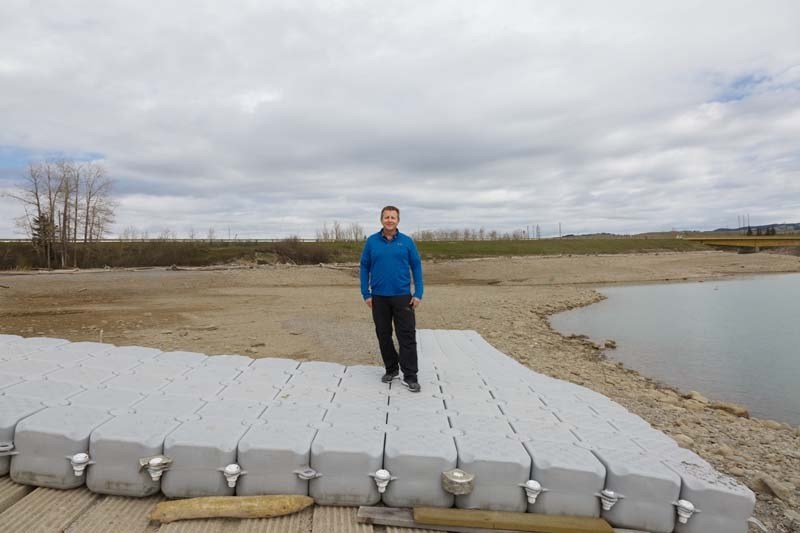The new normal for Mike Weinert remains a difficult pill to swallow.
The 21-year-long owner/operator of Ghost Lake Recreations and manager of the provincial campground is starting his fourth recreational season since the province launched its pilot to keep reservoir levels low for the first several weeks of the season as part of its flood mitigation plan.
“We’re way down … business is half of what it used to be,” said Weinert, explaining that with the water down roughly 18 feet, boat launching is onerous for those without a 4WD vehicle and not possible for keel boats (recreational sail boats).
Fifty moorings once full by this time now sit empty, with more than half dry and rendered unusable for the time being due to the water level, which is being kept around 1,186 metres until the high risk of flood season passes.
Given the impact on the already short season, Weinert said he is simply seeing more boaters store their vessels elsewhere and boat on other lakes.
The boat launch on the south side of the lake is also unusable and Weinert said nobody from the province has contacted him as a stakeholder or reached out to confirm when the south launch would be rebuilt.
“I’m understanding of the flood mitigation … it’s just a difficult situation for us.”
According to Rick Friedl, regional manager with Alberta Environment and Sustainable Resource Development, the south launch is being designed and the reconstruction will take place in time for the 2018 boating season.
The province is in year two of a five-year agreement with TransAlta to manage lake levels, where Alberta Environment pays the operator $5.5 million each year.
The agreement spans May 16 to July 7 of each year – what is deemed the highest risk period for flooding – and will be brought back up to normal levels of 1,191 metres toward the end.
“The whole intent is to have that storage in the event of a major event,” said Friedl, adding that the Kananaskis river reservoirs (Barrier, Upper and Lower Kananaskis) are included in the agreement from a drought mitigation perspective; the Ghost reservoir is for the purpose of flood mitigation.
“Last year we saw an average to below average snow pack and saw snow melt two to three weeks early,” said Friedl. “This year what we are seeing is above-average snow pack and a more normalized melt.”
Mike Mondor and Corleen Schultz own and operate Ghost Station, a convenience/fuel/storage centre near the lake.
Mondor said he has noticed fewer boats being hauled to the lake each season – as the already short boating season is reduced further with the province’s water management approach.
“I can see what they are trying to do but it does affect tourism in the area,” said Mondor, who wonders why the province couldn’t raise the levels at least a couple of metres to reduce the negative impacts on recreation.
Mondor also questions the efficacy of the program in the face of a “100-year event” like the flood of 2013.
Friedl said the province is working with residents in Ghost Lake Village with fire suppression systems and providing solutions to the well issues suffered by residents due to the low water levels.
He added that it’s a “balancing act” to address flood mitigation concerns downstream and that there are “diverse opinions of how to use the reservoir.”
For Banff-Cochrane NDP MLA Cameron Westhead, the water management is the best compromise in response to flood mitigation.
“It is estimated that modified operations at Ghost Reservoir would reduce peak flows along the Bow River by an additional 100 cubic metres per second,” said Westhead.
“This is on top of the peak flow reduction of around 400 cubic metres per second that was provided by the upstream TransAlta reservoirs during the 2013 floods. The location of Ghost Reservoir makes it an effective tool for flood mitigation.”




